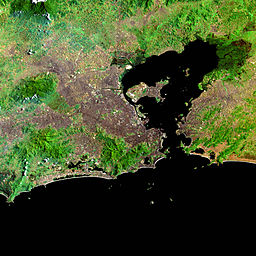| Guanabara Bay | |
|---|---|
| Baía de Guanabara (Portuguese) | |
 Satellite image of Guanabara Bay | |
| Location | Rio de Janeiro, Brazil |
| Coordinates | 22°47′25″S 43°9′20″W / 22.79028°S 43.15556°W |
| Type | Bay |
| River sources | |
| Ocean/sea sources | South Atlantic |
| Max. length | 31 km (19 mi) |
| Max. width | 28 km (17 mi) |
| Surface area | 412 km2 (159 sq mi) |
| Islands | Ilha do Governador, Ilha de Paquetá, Freguesia |
| Settlements | Rio de Janeiro, Niterói, Duque de Caxias, São Gonçalo |
Guanabara Bay (Portuguese: baía de Guanabara, baía da Guanabara,[1] [ɡwɐ̃nɐˈbaɾɐ]) is an oceanic bay located in Southeast Brazil in the state of Rio de Janeiro. On its western shore lie the cities of Rio de Janeiro and Duque de Caxias, and on its eastern shore are the cities of Niterói and São Gonçalo. Four other municipalities surround the bay's shores. Guanabara Bay is the second largest bay in area in Brazil (after the All Saints' Bay), at 412 square kilometres (159 sq mi), with a perimeter of 143 kilometres (89 mi).
Guanabara Bay is 31 kilometres (19 mi) long and 28 kilometres (17 mi) wide at its maximum. Its 1.5 kilometres (0.93 mi) wide mouth is flanked at the eastern tip by the Pico do Papagaio (Parrot's Peak) and the western tip by Pão de Açúcar (Sugar Loaf).
The name Guanabara comes from the Tupi language, goanã-pará, from gwa "bay", plus nã "similar to" and ba'ra "sea".[citation needed] Other glosses include hidden water,[2] lagoon of the sea,[3] and bosom of the sea.[4]
- ^ Guanabarino | Michaelis On-line
- ^ Franco, Paulo (2014). Diversity – The Brazilian Essence: Knowing Brazil By the Culture of Their People. Lulu.com. pp. 47–49. ISBN 9781483412559. Retrieved 3 January 2018.
- ^ Travel, D. K. (12 January 2016). DK Eyewitness Travel Guide Brazil (First American Edition, 2007 ed.). p. 92. ISBN 9781465452016. Retrieved 3 January 2018.
- ^ Museum of Tomorrow (PDF). p. 47. Archived (PDF) from the original on 4 January 2018. Retrieved 3 January 2018.
Of the indigenous tribes that lived along its banks, there are now only reports, a few middens and the original Tupi-Guarani names that continue to identify the geographical features and places along its shores, starting with its own name, Guanabara, or "bosom of the sea"...
